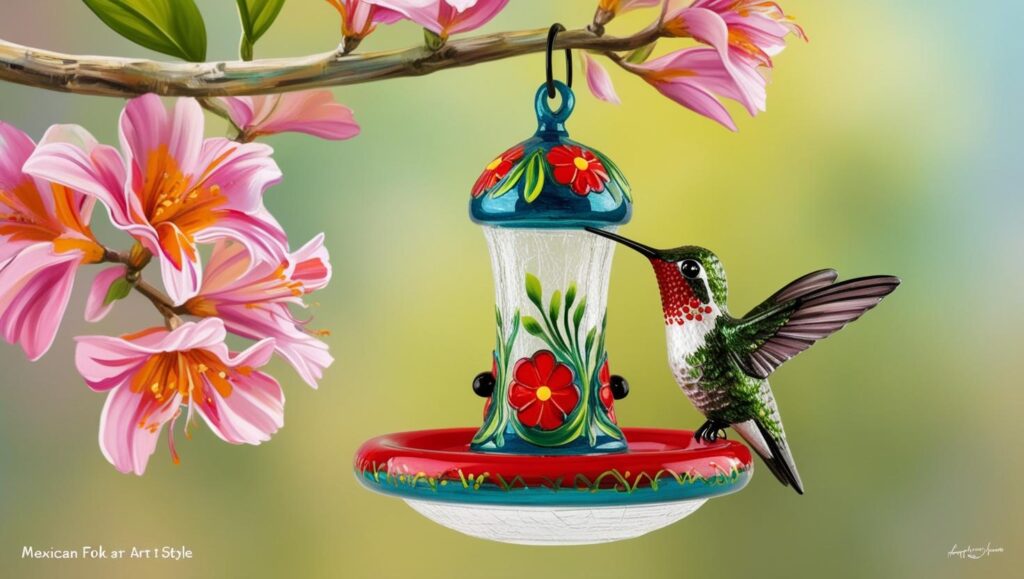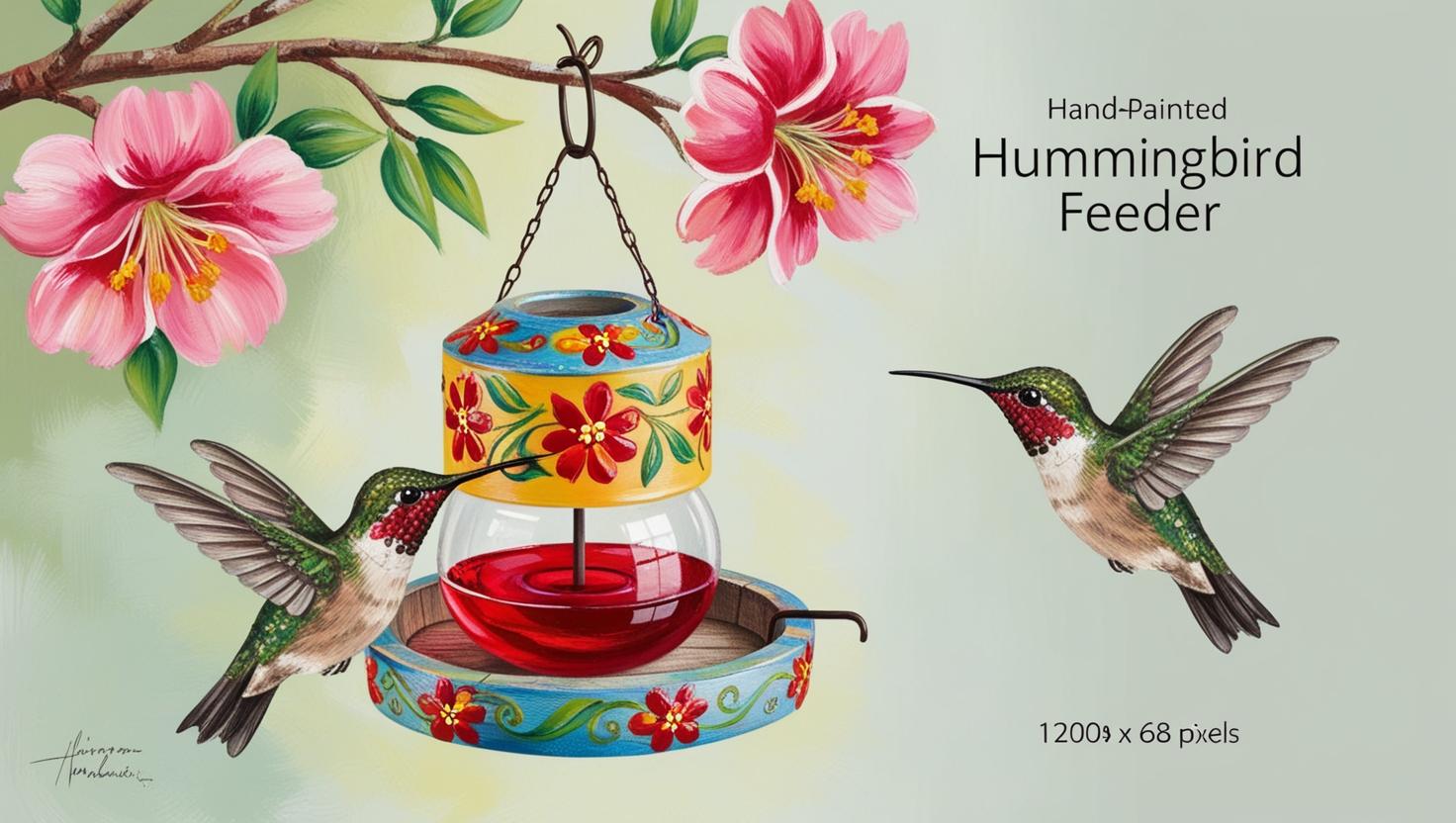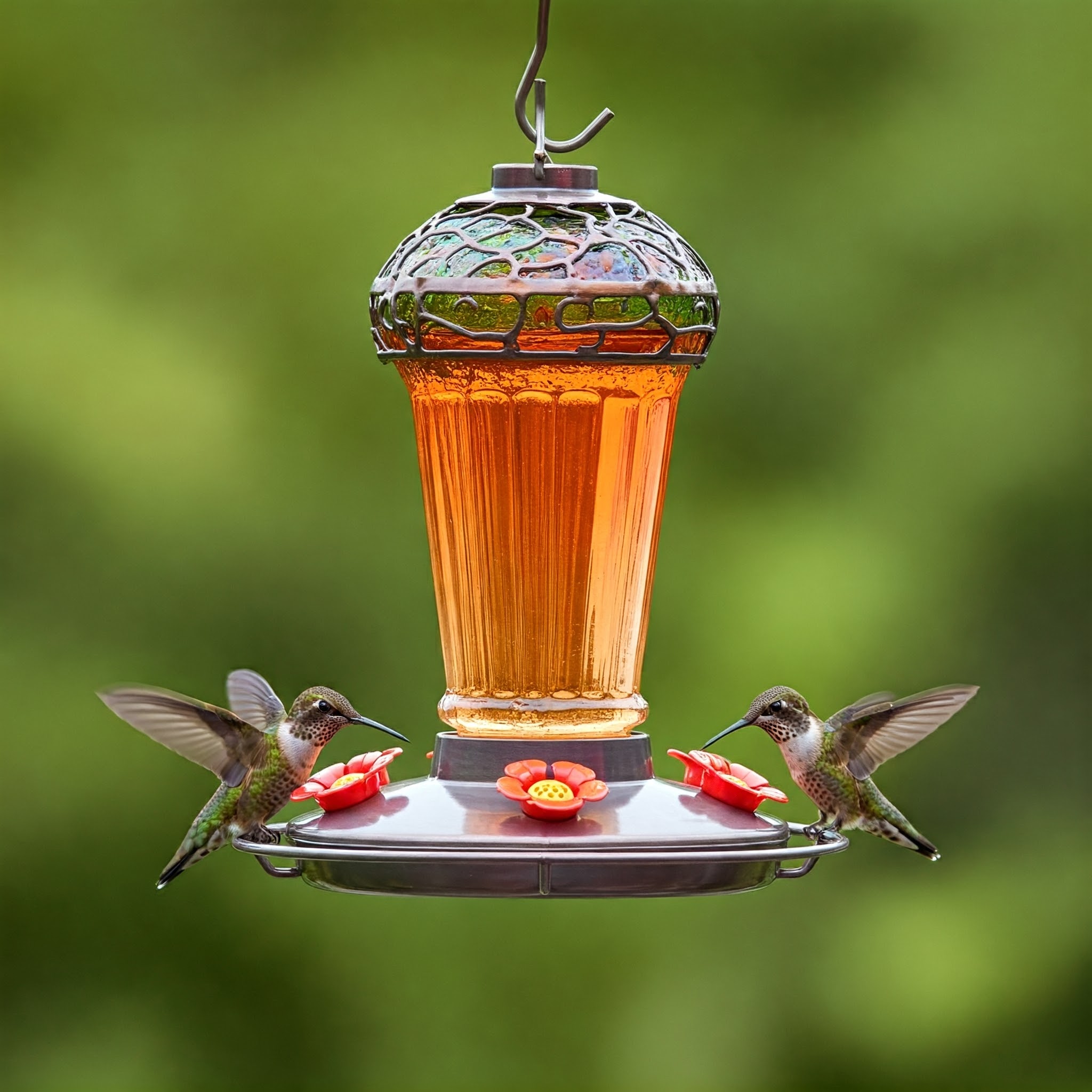In the world of backyard birdwatching, few sights rival the delicate grace and iridescent glow of a hovering hummingbird, its wings beating almost imperceptibly as it sips nectar. These tiny avian wonders captivate our imagination and foster a deeper connection to the natural world. For bird enthusiasts and garden lovers, adding a hand painted hummingbird feeder is not only a practical way to attract these beautiful birds, but it also serves as a piece of functional art, enhancing the aesthetic appeal of any outdoor space.
This article aims to provide a comprehensive understanding of what a hand painted hummingbird feeder is, explore its benefits, and guide you on how best to integrate it into your garden. We will also discuss the features of a decorative hummingbird feeder, delve into the charm of a hand painted glass hummingbird feeder, and offer valuable tips to ensure the best birdwatching experience. By investing in a hand painted hummingbird feeder—whether it be wooden, glass, or a combination thereof—you can enjoy both the practical and aesthetic rewards that come from elevating your garden sanctuary.

What Is a Hand Painted Hummingbird Feeder?
A hand painted hummingbird feeder is a nectar-dispensing vessel specifically designed and adorned by skilled artisans. Unlike mass-produced, plastic feeders, hand painted varieties often involve intricate craftsmanship, with delicate patterns, vibrant colors, and artful motifs that transform a simple feeding station into a decorative focal point. These feeders can be constructed from a variety of materials, including glass and wood, each offering its own aesthetic and structural advantages.
Beyond their obvious visual appeal, these feeders are thoughtfully engineered to meet the unique needs of hummingbirds. The nectar ports, perches, and reservoir sizes are all carefully considered to attract and accommodate hummingbirds comfortably. With their shimmering wings and curious nature, hummingbirds are irresistibly drawn to bright colors and artistic patterns, making the carefully chosen hues of a hand painted hummingbird feeder especially alluring to them.
Features of a Decorative Hummingbird Feeder
1. Artistic Design:
A decorative hummingbird feeder is defined by its visual beauty. Each feeder often features intricate hand painted patterns inspired by nature, such as floral motifs, subtle leaf designs, or even abstract art that complements garden landscapes. This artistry does more than simply catch the eye; it creates a cohesive and inviting environment, encouraging hummingbirds and other pollinators to frequent your outdoor space.
2. Quality Materials:
Durability and longevity are essential in hummingbird feeders. Decorative feeders are often crafted from glass, wood, or sturdy metal accents to ensure they can withstand variable weather conditions. High-quality materials also help maintain the purity of the nectar inside, ensuring a clean, safe meal for your tiny visitors.
3. Proper Nectar Ports and Perches:
A decorative hummingbird feeder is not just a pretty face. Its craftsmanship extends to functional features like precisely sized nectar ports and comfortable perches. This thoughtful design keeps the hummingbirds relaxed and encourages them to return, making your garden a reliable feeding station.
4. Easy Maintenance:
Even the most beautifully designed feeder must be easy to clean and refill. Decorative hummingbird feeders commonly include simple assembly parts and wide openings, allowing for quick disassembly, thorough cleaning, and convenient nectar replenishing. Cleanliness is critical to prevent mold and bacterial growth in the sugar-water solution.
The Allure of a Hand Painted Glass Hummingbird Feeder
A hand painted glass hummingbird feeder stands apart with its translucent elegance and eye-catching brilliance. When sunlight filters through hand painted patterns on a glass feeder, it creates a kaleidoscopic effect, catching the eye of hummingbirds and garden guests alike. Glass feeders also tend to be more durable against UV damage and resist absorbing odors, helping maintain the freshness of the nectar for longer periods.
The glass material allows you to monitor the nectar level at a glance, making timely refills more convenient. Moreover, many hand painted glass feeders can be considered heirloom pieces of functional art, passed down through generations to share the joy of hummingbird watching and garden appreciation.
Why Invest in a Wooden, Hand Painted Hummingbird Feeder?
While glass feeders are undeniably elegant, a wooden hummingbird feeder brings its own rustic charm and warmth to your garden. Investing in a wooden hummingbird feeder that is hand painted allows you to enjoy several distinct benefits:
- Natural Aesthetics:
Wood lends an organic, earthy feel that blends seamlessly with any outdoor setting. When adorned with delicate, hand painted designs—perhaps floral motifs or woodland scenes—the wooden feeder becomes an extension of your garden’s natural beauty. - Sustainability:
Choosing sustainably sourced wood supports responsible forestry and environmental stewardship. Wooden feeders are often durable, easy to maintain, and less likely to end up in landfills. - Longevity and Versatility:
A well-crafted, hand painted wooden feeder can endure the elements with proper care. Wood can be sealed with non-toxic varnishes to protect it from humidity and pests. Additionally, its natural appearance can complement various garden styles, from cottage to modern landscapes. - Unique Artistic Expression:
Each handmade wooden feeder is inherently unique. Subtle variations in wood grain, texture, and the brushwork of the artist’s paint ensure that no two feeders are exactly alike. In choosing a wooden, hand painted hummingbird feeder, you’re investing in a one-of-a-kind piece that truly expresses your personality and tastes.
Enhancing Your Birdwatching Experience
Investing in a hand painted hummingbird feeder can greatly enhance your birdwatching experience. Here are several ways to make the most of it:
1. Placement Matters:
Install the feeder in a quiet, sheltered spot with partial shade to help preserve the nectar’s quality. Positioning the feeder near flowers, shrubs, and other natural elements encourages hummingbirds to linger and explore the garden. Also, placing it within view of a window or outdoor seating area makes observation more enjoyable.
2. Consistent Maintenance and Cleaning:
One of the critical factors for attracting hummingbirds is cleanliness. Change the nectar (a simple sugar-water solution of about one part white granulated sugar to four parts water) every 3-4 days and more frequently in hot climates. Regular cleaning and inspection ensure no harmful molds or bacteria grow, keeping hummingbirds safe and healthy.
3. Creating a Safe Environment:
Keeping cats, large birds, and other predators at bay ensures hummingbirds feel comfortable. Positioning the feeder high enough or strategically near bushes allows hummingbirds to hide if a threat arises. Additionally, avoid using pesticides or harmful chemicals that could contaminate the nectar or the environment.
4. Supplementary Plantings:
Hummingbirds are attracted to bright, tubular flowers like salvias, fuchsias, and trumpet vines. Surrounding your hand painted hummingbird feeder with hummingbird-friendly plants creates a holistic feeding station that combines natural nectar sources with your artistic feeder for maximum appeal.
5. Patience and Observation:
Hummingbirds are creatures of habit. Once they find a reliable feeding source, they return daily. Giving them time to discover your feeder and maintaining a consistent routine—fresh nectar, cleanliness, and a welcoming environment—ensures steady visits. With patience, you’ll have countless opportunities to admire their beauty, grace, and fascinating behavior.
Choosing the Right Hand Painted Hummingbird Feeder
When selecting a hand painted hummingbird feeder, consider these factors:
- Material and Craftsmanship: Determine whether glass, wood, or a combination of materials aligns with your garden aesthetic and maintenance preferences. High-quality construction ensures durability and safety.
- Design and Color: Opt for feeders with bright colors (reds, yellows, and oranges) and intricate patterns. Hummingbirds are attracted to vibrant hues, and a well-chosen design can serve as both a functional tool and a garden art piece.
- Ease of Cleaning: Ensure that all parts can be easily disassembled, allowing you to maintain a hygienic feeding station effortlessly.
- Artistic Value: Consider the artist’s style and the uniqueness of the design. A one-of-a-kind, hand painted piece can bring you joy for many seasons to come.
Frequently Asked Questions (FAQs)
1. How often should I change the nectar in my hand painted hummingbird feeder?
Ideally, change the nectar every 3-4 days. In hotter climates, you may need to replace it more frequently to prevent fermentation or bacterial growth.
2. What is the best sugar-to-water ratio for hummingbird nectar?
A standard ratio is one part white granulated sugar to four parts water. Do not use honey, brown sugar, or artificial sweeteners, as they can harm hummingbirds.
3. Do I need to add red dye to the nectar?
No. Red dye is unnecessary and may be harmful to hummingbirds. The feeder’s bright colors are sufficient to attract them without artificial additives.
4. Can I hang a decorative hummingbird feeder in direct sunlight?
While hummingbirds love sunlight, direct sunlight can heat the nectar and cause it to spoil quickly. Try placing the feeder in partial shade to keep nectar fresh longer.
5. How can I protect my hand painted hummingbird feeder from ants and bees?
Use nectar guards, ant moats, or position the feeder away from known insect trails. Keeping the feeder clean and free from nectar drips also reduces insect attraction.
6. Will hummingbirds visit my feeder year-round?
This depends on your geographic location. In many regions, hummingbirds migrate. However, if you live in an area with year-round hummingbird populations, maintaining a clean, well-stocked feeder may attract them continuously.
7. How do I clean my hand painted hummingbird feeder without damaging the paint?
Use warm water and a mild, non-toxic soap. Avoid abrasive cleaners or brushes that could chip the paint. Gently wipe and rinse thoroughly before refilling.
8. Can I use multiple hummingbird feeders in my yard?
Yes. Multiple feeders, spaced apart, can accommodate more hummingbirds and reduce territorial disputes between visiting birds.
9. How long does it take for hummingbirds to find a new feeder?
It can vary. Some hummingbirds may find it within days, while others may take a week or two. Consistent maintenance and placement near flowers increase your chances.
10. Are hand painted hummingbird feeders worth the investment?
Absolutely. They combine functionality with artistry, enhancing your outdoor space and providing a sustainable, decorative attraction for hummingbirds for many seasons.
Conclusion
A hand painted hummingbird feeder is much more than a simple garden accessory. It represents a harmonious blend of art, nature, and functionality. Whether you select a hand painted glass hummingbird feeder that catches the sunlight and mesmerizes both you and the birds, or a rustic wooden model that embodies natural beauty, you’ll find yourself rewarded with enhanced birdwatching experiences and a garden that feels truly alive.
By carefully choosing, maintaining, and placing your decorative hummingbird feeder, you create a welcoming haven for these jewel-like birds. Over time, you will witness the subtle joys of nature—colorful blooms, fluttering wings, and the gentle hum of life just outside your window. Ultimately, investing in a hand painted hummingbird feeder is investing in delight, beauty, and a more profound connection to the natural world.


